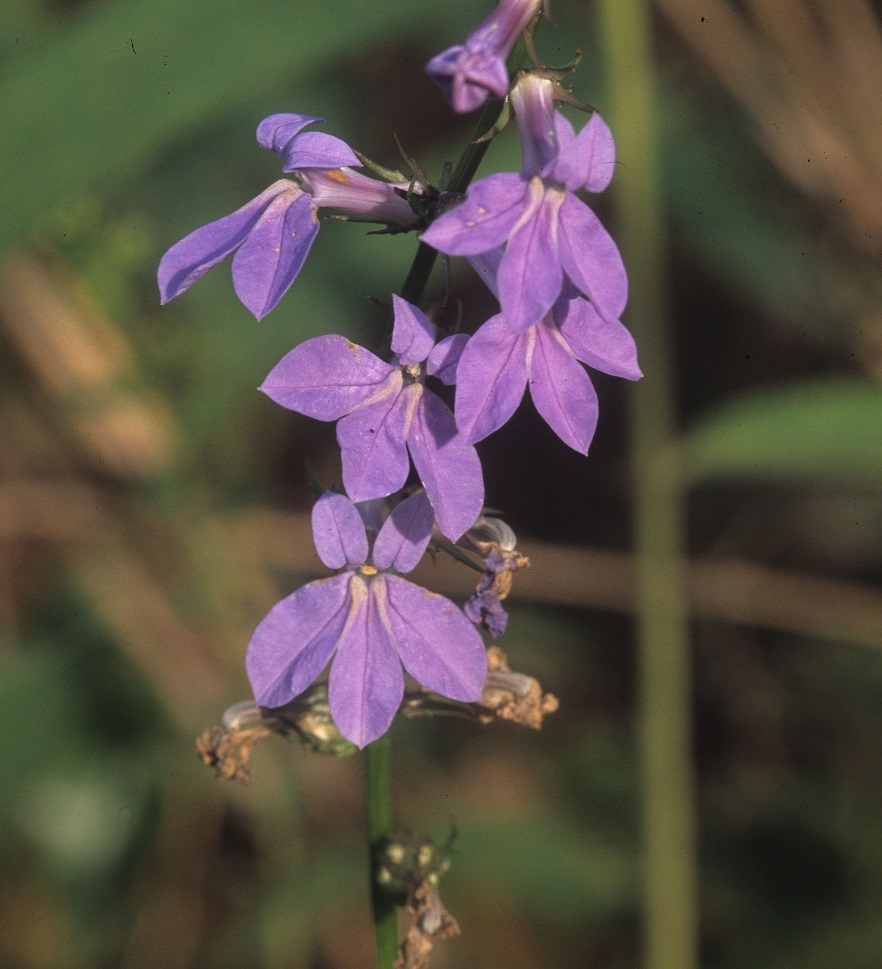Lobelia amoena
| Lobelia amoena | |
|---|---|

| |
| Photo taken by Gil Nelson | |
| Scientific classification | |
| Kingdom: | Plantae |
| Division: | Magnoliophyta - Flowering plants |
| Class: | Magnoliopsida – Dicotyledons |
| Order: | Campanulales |
| Family: | Campanulaceae |
| Genus: | Lobelia |
| Species: | L. amoena |
| Binomial name | |
| Lobelia amoena Michx. | |

| |
| Natural range of Lobelia amoena from USDA NRCS Plants Database. | |
Common name: Southern lobelia
Contents
Taxonomic notes
Synonym: Lobelia amoena var. amoena
Description
"Perennial or annual herbs, stems erect, strict or freely branched. Leaves crenate, serrate or entire. Raceme terminal ,bracteate, often very leafy and the flowers appearing axillary. Calyx 5-lobed, more or less actinomorphic; corolla zygomorphic, fenestrate, 2-lipped, upper lip 2-lobbed, lower 3-lobbed. Stamens 5, completely united. Capsule dehiscent by apical pores. Seeds yellowish brown, tuberculate, oblong, 0.6-1 mm long." [1]
"Similar to L. elongata. Leaves elliptic to lanceolate, 4-15 cm long, 2-4 cm wide. Sepals entire or remotely glandular-serrate; corolla tube 7-9 mm long; filament tube 5-7 mm long. Capsule 6-8 mm broad." [1]
Distribution
Ecology
Habitat
This species can be found in floodplain forests, semi-open wetlands, along river and stream banks, seepage bogs, and low depressions. [2] It grows in shaded to deep shaded environments in wet or dry sands and loam of mesic wooded environments. [2] L. amoena also grows in human disturbed areas such as roadside ditches and clear-cut woods. [2] L. amoena responds negatively to soil disturbance by heavy silvilculture in North Carolina.[3] Associated species include Boltonia, Commelina, Coreopsis integrifolia, Physostegia virginiana, Woodwardia areolata, Quercus, Rhamnus, oakleaf hydrangea, Conoclinium, Pluchea, Leersia, Panicum, Schoenus, Juniperus, Solidago fistulosa, and Bidens alba. [2]
Phenology
This species has been observed flowering from September to November. [2]
Fire ecology
This species has been found in annually burned areas. [2]
Conservation and management
Cultivation and restoration
Photo Gallery
References and notes
- ↑ 1.0 1.1 Radford, Albert E., Harry E. Ahles, and C. Ritchie Bell. Manual of the Vascular Flora of the Carolinas. 1964, 1968. The University of North Carolina Press. 1005-7. Print.
- ↑ 2.0 2.1 2.2 2.3 2.4 2.5 Florida State University Robert K. Godfrey Herbarium database. URL: http://herbarium.bio.fsu.edu. Last accessed: June 2014. Collectors: Loran C. Anderson, W. W. Baker, A. Gholson Jr., James P. Gillespie, Robert K. Godfrey, D. Hall, R. Komarek, R. Kral, N. Lee, Sidney McDaniel, Richard S. Mitchell, Gil Nelson, R. A. Norris, Camm Swift, D. B. Ward, and Rodie White. States and Counties: Florida: Calhoun, Franklin, Gadsden, Jackson, Leon, Liberty, Wakulla, Walton, Washington. Georgia: Grady and Thomas.
- ↑ Cohen, S., R. Braham, and F. Sanchez. (2004). Seed Bank Viability in Disturbed Longleaf Pine Sites. Restoration Ecology 12(4):503-515.